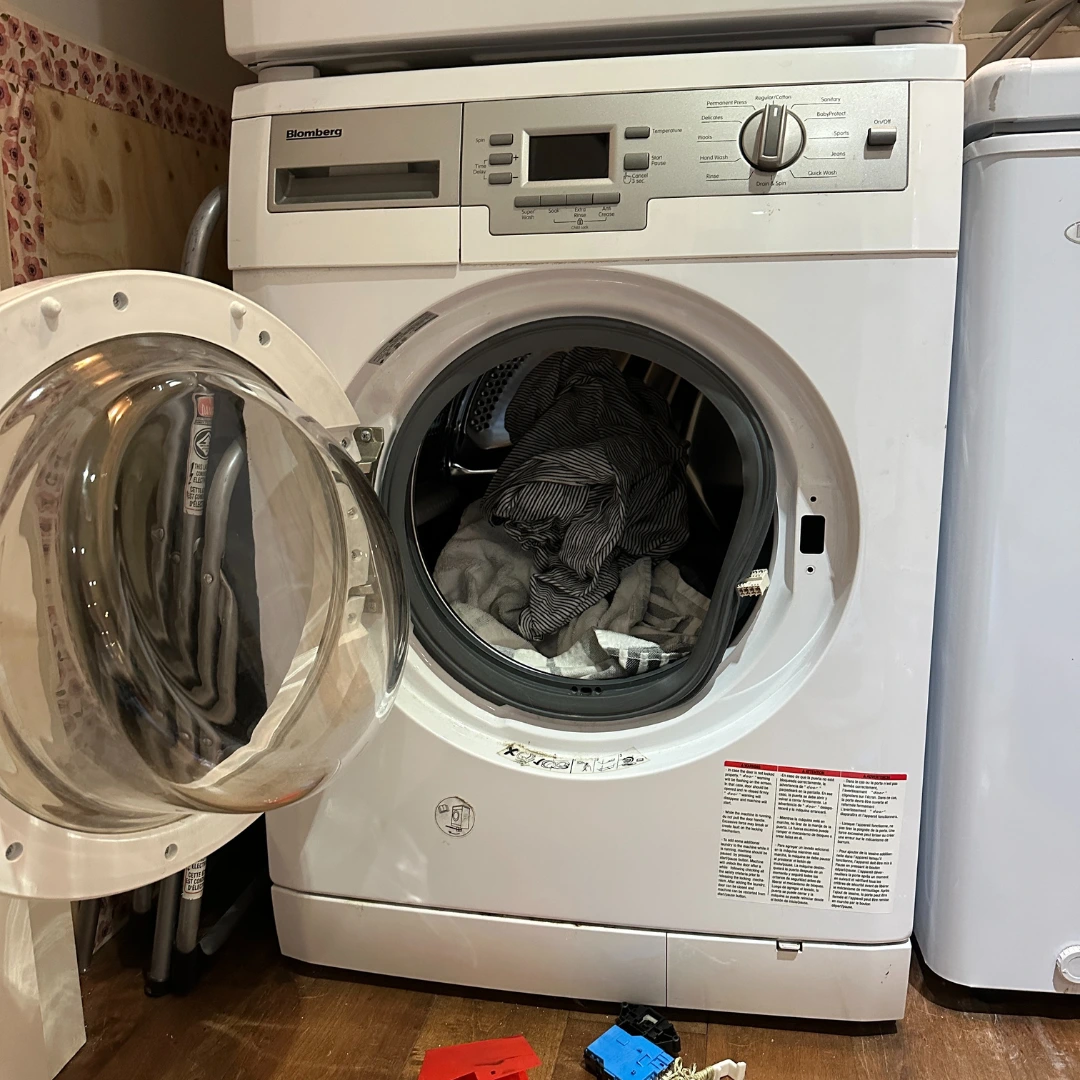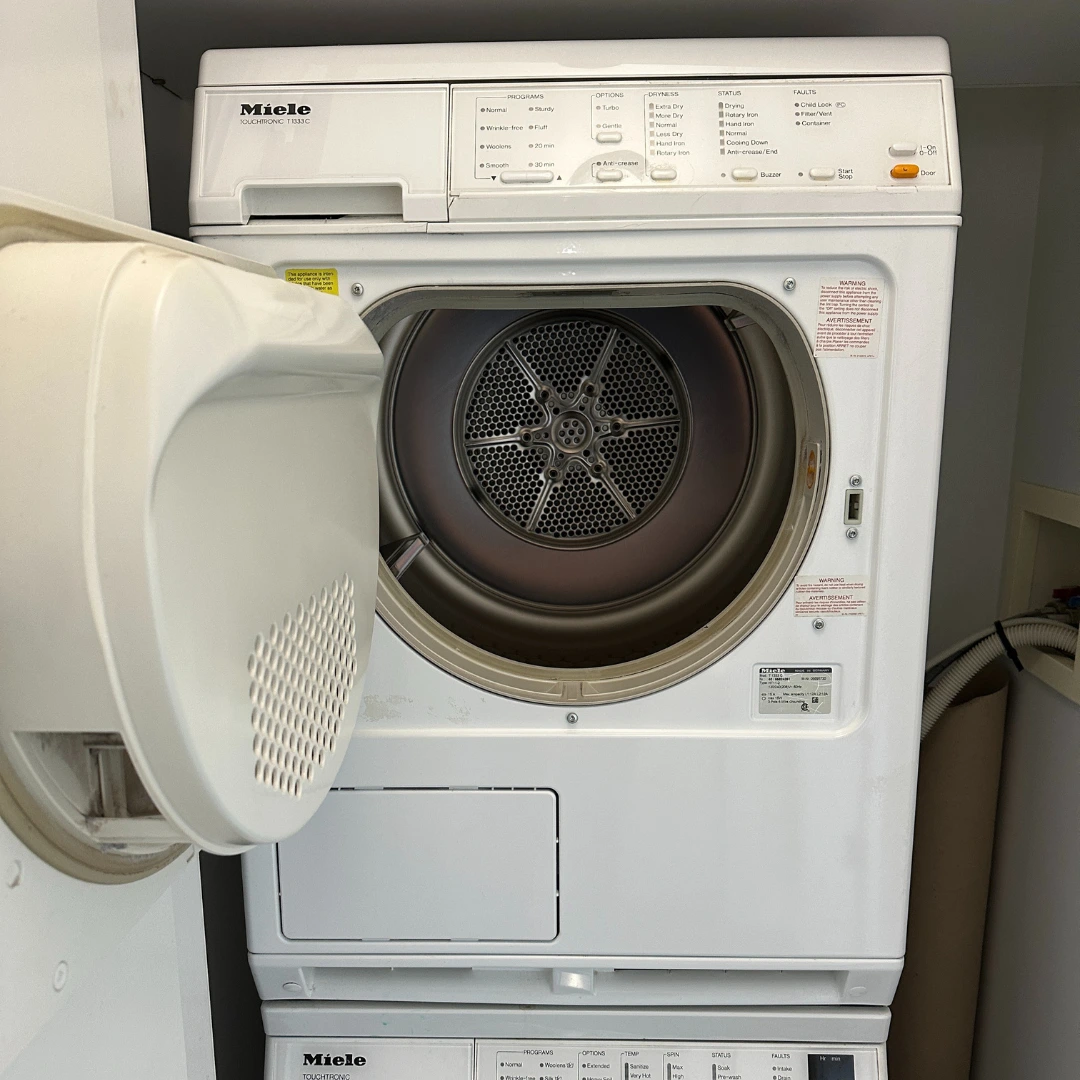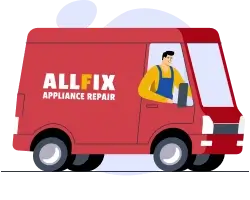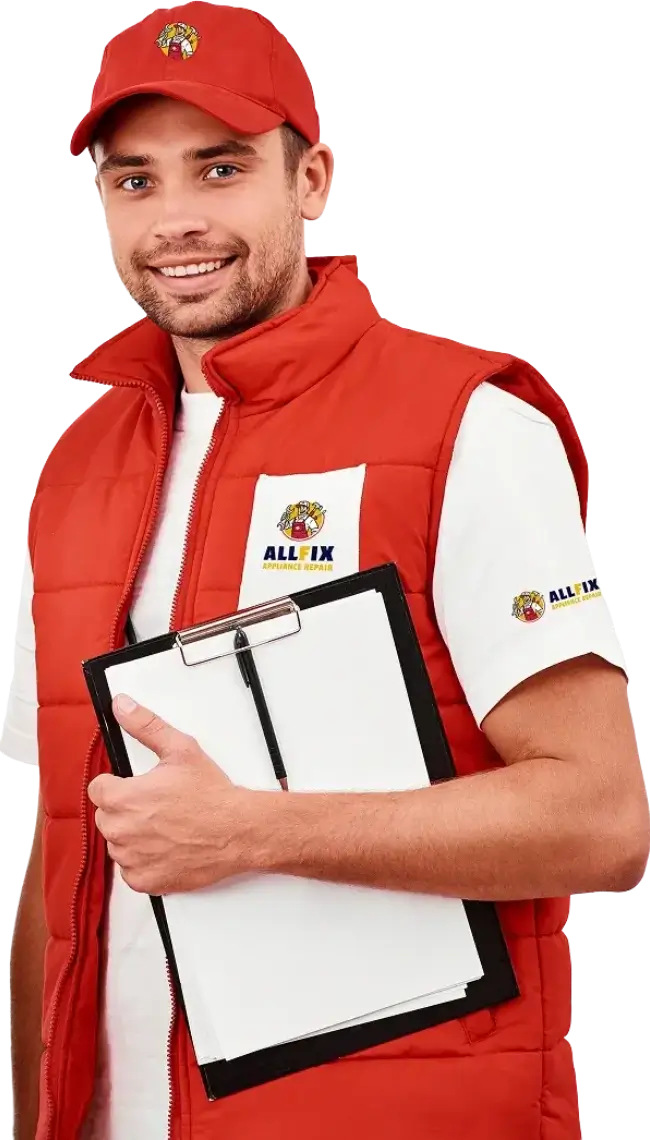Schedule Repair

Washer trouble? BOOK Reliable REPAIRS today
Schedule Your Washer Repair Today!
Need help with your washer? From leaks to loud cycles, we’ll have it fixed in no time. Book today for cost-effective and reliable repair services for your clothes washer!
Schedule Repairs Online
Warranty Protection
Cost-Effective Solutions
Why choose us for washer Repair?
Long-Lasting Repairs For Clothes Washers
Call All Fix for the best appliance repair services throughout Vancouver, Surrey, Richmond and surrounding areas! Our team of certified washer repair technicians will complete a detailed diagnostic test to identify the problem, providing accurate quotes based on the results so you know the costs before we begin the repair. Call us today to book your clothes washer repair service!
- Same-Day Repair Service
- Free Service Call With Repair
- Certified Washer Repair Technicians With 15 Years Experience
- Repairing All Makes And Models
- Genuine Manufacturer Replacement Parts

Discounts & Offers
Save On Repairs With Exclusive Coupons!
Enjoy discounted appliance repairs in Vancouver and surrounding areas! Get your coupon today to enjoy affordable repairs for your home appliances.
$30 OFF

Any Repair
Appliance Repair Coupon
$15 OFF

Senior's
Discount
Appliance Repair Coupon
$10 OFF

For VIP
Customers
Appliance Repair Coupon
clients reviews
Hear From Our Happy Customers!
Get Fast, Reliable Appliance Repairs!
Need a Fix? We’re Here to Help!
Call now and let our technicians solve your appliance issues fast.

WHY YOU CAN RELY ON US
Your Trusted Repair Experts!
Same-Day Washer Repairs
Book same-day services for emergency clothes washer repairs.
Certified Washer Repair Technicians
All of our repair technicians are certified, licensed and insured.
Warranty Package For All Repairs
All of our washer repair services come with a great warranty package.
Detailed Diagnostic Tests For Washers
This allows us to quickly identify the issue and provide accurate pricing.
Affordable Clothes Washer Repairs
Save money when you book our affordable repairs for clothes washers!
CLOTHES WASHER TROUBLESHOOTING steps
Common Problems With Your Washer
(And How To Fix Them)
If you have noticed any of these issues, try our troubleshooting steps to see if you can save yourself a repair call. If the problem persists or you would like a professional to take a look then give us a call today!
1. No Power Supply:
This is the simplest and often overlooked cause.
- Check the power cord: Ensure the washing machine’s power cord is securely plugged into a working electrical outlet. Sometimes, it can become loose.
- Test the outlet: Plug another small appliance (like a lamp or a phone charger) into the same outlet to confirm it’s receiving power. If the other appliance doesn’t work, the outlet might be dead.
- Check your circuit breaker: Go to your home’s electrical panel and look for tripped circuit breakers. A tripped breaker will usually be in the “off” position or halfway between “on” and “off.” Flip it completely off and then firmly back to the “on” position. If it immediately trips again, there might be an electrical issue that requires an electrician.
- GFCI outlet: If your washing machine is plugged into a Ground Fault Circuit Interrupter (GFCI) outlet (which has “reset” and “test” buttons), press the “reset” button.
2. Lid Switch/Door Latch Issue:
Modern washing machines, for safety, won’t start if the lid or door isn’t properly closed and latched.
- Close the lid/door firmly: Make sure the lid or door is completely closed and latched. You might hear a “click” indicating it’s secure.
- Inspect the latch: Visually inspect the latch mechanism on the door/lid and the corresponding strike on the machine. Look for any signs of damage, obstruction, or misalignment.
- Check for obstructions: Ensure no clothing or other items are preventing the lid or door from closing fully.
3. Control Panel/Timer Problem:
Less common, but sometimes the control panel or timer itself can malfunction.
- Reset the machine: Try unplugging the washing machine for a few minutes (5-10 minutes) and then plugging it back in. This can sometimes reset the electronic controls.
- Examine control settings: Ensure the cycle selector knob is properly aligned with a cycle setting and not stuck between two.
1. Loose or Damaged Hoses:
The inlet and drain hoses are common culprits for leaks.
- Check inlet hoses: Inspect the hot and cold water inlet hoses connected to the back of your washing machine. Ensure they are tightly screwed on at both ends (to the machine and to the wall faucets). Look for cracks, bulges, or signs of wear. If a hose appears damaged, it needs to be replaced.
- Check drain hose: Examine the drain hose for any cracks or holes. Ensure it’s securely positioned in the standpipe or laundry tub and isn’t pushed in too far (which can cause siphoning issues).
2. Overloading the Machine:
Too many clothes can lead to excessive suds and water overflow.
- Reduce load size: Always adhere to the manufacturer’s recommended load size. When in doubt, it’s better to wash smaller loads. The clothes should have room to tumble freely, not be packed tightly.
3. Too Much Detergent:
Excessive suds can escape the machine, mimicking a leak.
- Use correct detergent amount: Follow the detergent manufacturer’s recommendations for load size and water hardness. Using high-efficiency (HE) detergent in HE machines is crucial as it produces fewer suds.
- Run a rinse cycle: If you suspect oversudsing, run an empty rinse and spin cycle to clear out excess detergent.
4. Clogged Drain Pump Filter:
A clogged filter can cause water to back up and leak.
- Locate and clean filter: Consult your washing machine’s manual to find the location of the drain pump filter (often at the bottom front of the machine). Place towels and a shallow pan underneath to catch water. Carefully open the filter cover and remove any lint, debris, or small items.
- Drain remaining water: Some machines have a small hose near the filter to drain water before fully removing the filter.
5. Cracked Tub or Gasket/Seal Damage:
More serious issues can cause leaks from the internal components.
- Inspect door gasket (front-loaders): For front-loading machines, thoroughly inspect the rubber door gasket (bellow) for tears, holes, or mold buildup. Clean the gasket regularly. If it’s torn, it needs professional replacement.
- Look for internal leaks: This often requires professional diagnosis, as it can indicate a cracked wash tub or a failing pump. If you see water pooling underneath the machine but can’t identify an external hose issue, it’s time to call a technician.
1. Clogged Drain Hose:
Debris or kinks in the drain hose can prevent water from exiting.
- Check for kinks: Ensure the drain hose isn’t bent, twisted, or kinked behind the machine or where it enters the standpipe/laundry tub.
- Clear clogs: Carefully remove the drain hose from the standpipe/laundry tub and inspect both ends for blockages (lint, foreign objects). You may need to run water through it to clear any internal clogs.
2. Clogged Drain Pump Filter:
As mentioned with leaks, a clogged filter directly impacts drainage.
- Clean the filter: Follow the steps outlined in “Problem 2: Washing Machine is Leaking water” to locate and clean your drain pump filter. This is a very common reason for drainage issues.
3. Malfunctioning Drain Pump:
If the hose and filter are clear, the pump itself might be faulty.
- Listen for pump noise: During the drain cycle, listen for the sound of the drain pump operating. If you hear no sound or unusual grinding/humming, the pump might be failing. This usually requires professional replacement.
4. Improper Installation of Drain Hose:
If the drain hose is pushed too far down into the standpipe, it can create a siphoning effect that prevents proper draining.
- Check hose height: The drain hose should ideally form an air gap and not be inserted more than 6-8 inches into the standpipe or laundry tub. Consult your manual for the correct height and positioning.
1. Unbalanced Load:
This is the most common cause of banging and vibrating noises, especially during the spin cycle.
- Redistribute clothes: Pause the cycle and open the lid/door. Manually redistribute the clothes evenly around the drum. If washing large, bulky items (like blankets or towels), try to wash them with a few smaller items to help balance the load.
- Avoid overloading: Don’t stuff the machine. Clothes need room to move freely.
2. Foreign objects in the drum/pump:
Coins, keys, or other small items can get stuck in the drum or find their way into the pump.
- Check drum interior: Before loading, check pockets for loose items. After a noisy cycle, carefully inspect the drum, especially around the agitator (top-loader) or between the drum and the outer tub (front-loader). You might need a flashlight.
- Check drain pump filter: Small objects can also end up in the drain pump filter, causing grinding noises. Clean the filter as described in “Problem 2” and “Problem 3.”
3. Worn Drum Bearings:
A rumbling or grinding noise, especially during the spin cycle, often points to worn-out drum bearings.
- Test the drum: With the machine empty and unplugged, try to spin the drum by hand. If it wobbles excessively or makes a loud grinding noise, the bearings are likely faulty. This is a complex repair best left to professionals.
4. Damaged Drive Pulley or Belt:
A screeching or thumping noise can indicate a problem with the drive system.
- Visual inspection (if accessible): If you are comfortable and can safely access the back panel of your machine (after unplugging!), you might be able to visually inspect the drive belt for fraying or looseness. However, this is generally a job for a professional technician.
5. Leveling Issues:
An unlevel machine can vibrate excessively and cause banging noises.
- Check level: Use a spirit level on top of your washing machine to check if it’s perfectly level from front-to-back and side-to-side.
- Adjust leveling feet: Most washing machines have adjustable feet at the bottom. Turn them clockwise or counter-clockwise to raise or lower the machine until it is stable and level. Ensure the locking nuts are tightened once adjusted.
1. Unbalanced Load:
The machine’s safety features may prevent spinning or agitation if the load is too unbalanced.
- Redistribute clothes: Pause the cycle and manually redistribute the clothes evenly within the drum. Try to avoid washing single, heavy items by themselves.
2. Lid switch/door latch malfunction:
As mentioned in “Problem 1: Washing Machine Won’t Turn On” a faulty lid switch or door latch can prevent the machine from starting or advancing to the spin/agitate cycle for safety reasons.
- Ensure proper closure: Make sure the lid or door is fully closed and latched. Test the switch by pushing it down (on top-loaders). If it doesn’t click or seems loose, it might be faulty.
3. Broken Drive Belt:
The belt that connects the motor to the transmission or drum can break or become loose.
- Listen for motor: If you hear the motor running but the drum isn’t moving, a broken belt is a strong possibility. This requires professional replacement.
4. Motor or Transmission Problems:
These are complex internal components that, when faulty, will prevent spinning or agitation.
- Professional diagnosis: If other troubleshooting steps fail, and you suspect a motor or transmission issue, it’s definitely time to call a professional technician.
5. Worn Clutch (Top-Loaders):
In older top-loading machines, the clutch assembly helps the tub gradually reach spinning speed. If it’s worn, the machine won’t spin effectively.
- Professional repair: Clutch replacement is a job for an experienced technician.
1. Overloading the Machine:
Too many clothes prevent proper agitation and water circulation, leading to poor cleaning.
- Load size: Don’t overfill the machine. Clothes need space to move freely in the water and detergent.
2. Too Much or Too Little Detergent:
Both extremes can hinder cleaning. Too much leaves residue, too little doesn’t clean.
- Follow directions: Use the recommended amount of detergent based on load size and water hardness. Use HE detergent for HE machines.
- Water hardness: If you have hard water, you might need slightly more detergent. Consider a water softener if your water is very hard.
3. Incorrect Water Temperature:
Using the wrong water temperature for the fabric type can impact cleaning.
- Check water temperature: Ensure your hot water supply is working correctly and that you’re selecting the appropriate temperature setting for your wash load. Whites and heavily soiled items typically benefit from warmer water, while delicate or dark colors prefer cooler.
4. Clogged Water Inlet Screens:
Sediment can block the screens where the water hoses connect, reducing water flow.
- Clean inlet screens: Turn off the water supply to the washing machine. Disconnect the hot and cold water inlet hoses from the back of the machine. Use needle-nose pliers to pull out the small filter screens inside the inlet valves. Rinse them under running water to remove sediment. Reinstall and reconnect the hoses.
5. Drainage Issues:
If water isn’t draining completely, dirty water might be redeposited on clothes.
- Review drainage sections: Revisit “Problem 3: Washing Machine is Not Draining Water” and ensure your drain hose and pump filter are clear.
6. Washer Needs Cleaning:
Mould, mildew, and detergent residue can build up in the machine, causing odors and affecting cleaning.
- Run a cleaning cycle: Run an empty hot water cycle with a washing machine cleaner, white vinegar, or baking soda.
- Clean gasket (front-loaders): Regularly wipe down the rubber door gasket to remove mold and mildew. Leave the door ajar after use to allow the drum to air dry.
- Clean detergent dispenser: Remove and clean the detergent dispenser drawer regularly.
1. Unbalanced Load:
As with spinning issues, an unbalanced load can trigger safety sensors, pausing the cycle.
- Redistribute clothes: Open the lid/door, rearrange the clothes to balance the load, and then restart the cycle.
2. Power Interruption:
A brief power flicker or outage can cause the machine to stop.
- Check power: Confirm the machine is still plugged in and the circuit breaker hasn’t tripped. If it was a momentary outage, the machine might simply need to be restarted.
3. Lid Switch/Door Latch Issues:
If the lid or door isn’t securely closed or the switch is intermittently faulty, the cycle might pause or stop.
- Ensure secure closure: Firmly close the lid/door. If the issue is intermittent, the switch may need to be replaced by a professional.
4. Water Supply Issues:
If the machine can’t fill with water, or the water pressure is too low, it may pause.
- Check water faucets: Ensure both hot and cold water supply faucets are fully open.
- Inspect inlet hoses: Check for kinks in the water inlet hoses.
- Clean inlet screens: As described in “Problem 6: Washing Machine Isn’t Cleaning Clothes Properly” clogged inlet screens can restrict water flow.
5. Overheating Motor:
If the motor overheats, a thermal cut-off switch will activate, pausing the machine to prevent damage.
- Let it cool: Allow the machine to cool down for 15-30 minutes, then try restarting the cycle. If this happens frequently, it indicates a motor problem that needs professional attention.
1. Reversed Hoses:
The hot and cold water inlet hoses might be connected to the wrong faucets at the wall.
- Check hose connections: Turn off water supply, then disconnect and reconnect the hot and cold hoses to their corresponding hot and cold faucets on the wall. The hot faucet is typically on the left, and the cold on the right.
2. Clogged Inlet Screens:
Sediment blocking one of the inlet screens can reduce flow from that specific line, leading to an imbalance in water temperature.
- Clean inlet screens: Follow the steps in “Problem 6: Washing Machine Isn’t Cleaning Clothes Properly” to clean both the hot and cold water inlet screens.
3. Faulty Water Inlet Valve:
The valve that controls water flow into the machine might be malfunctioning.
- Professional diagnosis: If the hoses are correctly connected and the screens are clean, a faulty water inlet valve usually requires professional replacement.
4. Water Heater Issues:
For hot water problems, check your home’s water heater.
Check water heater: Ensure your hot water heater is on and functioning correctly. Check its temperature settings.
1. Mould and Mildew Buildup:
Especially common in front-loading machines due to moisture trapped in the door gasket and dispenser.
- Clean door gasket: Regularly wipe down the rubber door gasket with a mixture of equal parts white vinegar and water, or a specialized washing machine cleaner. Pay attention to all crevices.
- Leave door ajar: After each wash, leave the washing machine door slightly ajar to allow the drum to air dry and prevent moisture buildup.
- Clean detergent dispenser: Remove and clean the detergent dispenser drawer regularly.
2. Detergent and Fabric Softener Residue:
These can accumulate and become a breeding ground for bacteria.
- Run a hot cleaning cycle: Run an empty hot water cycle with two cups of white vinegar or a washing machine cleaner. For tough odors, follow with another empty hot cycle using 1/2 cup of baking soda.
- Use less detergent: Overuse of detergent and fabric softener contributes to residue.
3. Drain Hose Issues:
If the drain hose is inserted too far into the standpipe, it can create a siphoning effect that draws sewer gases back into the machine.
- Check drain hose position: Ensure the drain hose is not pushed more than 6-8 inches into the standpipe and that there’s an air gap.
Prevent Future Breakdowns
We Repair All Makes & Models


Stress-Free WASHER Repairs
Your Local Washer Repair Company
Are you are having issues with your washer? Maybe it is leaking, not washing your clothes properly, or keeps giving you the same error message over and over again? All Fix is open 7 days a week, has 15 years experience, and is certified to repair all major washer makes and models. We are the best choice when searching for a “clothes washer repair company near me” in Vancouver, Surrey, Richmond or the surrounding areas. We can repair the following clothes washer models:
- Front load washer
- Top load washer
- Portable clothes washer
- Washer-dryer combo
- Stacked washer and dryer
- Laundry centers
- Agitator washer
- Impeller washer
- Washers with 2 in 1 agitator and impeller
- Compact washing machines
- High-efficiency (HE) washers
- Pet friendly washing machines
4 easy steps
Our Repair Process

Step 1
Book an Appointment
Book your repair in a few easy steps online or via the phone using our booking process.

Step 2
Expert Diagnosis
Our technician will arrive precisely on time, diagnose your appliance and explain in detail.

Step 3
Transparent Quote & Repair
You get an upfront quote, and we get to work on repairing your appliance upon approval.

Step 4
Satisfied Customer
We ensure everything works to perfection and support it with our satisfaction guarantee.
Don’t Let Dirty clothes Slow You Down
Washing Machine Broken? Contact Us!
Why wait? Your washing machine deserves only the best! Give us a call today, and let’s get that laundry going.
We give you a full guarantee of a friendly, no-hassle experience. We give exclusive discounts to make it even more affordable.

CALL US TODAY!
(604) 907-1707























